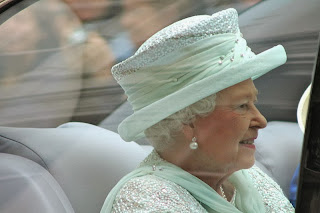St. Paul's Cathedral from the Thames, 1850
St. Paul's, Today
St. Paul's is not only the mother church of the Diocese of London in the Church of England, it is a national symbol and the site of many national events: weddings, funerals, and significant celebrations.
Queen Elizabeth II arrives at St. Paul's 4 June 2012
It shares these roles with Westminster Abbey; St. Paul's was the site of the service of national thanksgiving to commemorate the Queen's Diamond Jubilee in 2012, and the Abbey in 2013 hosted the service of national thanksgiving to commemorate the 60th anniversary of the Queen's coronation.
Commemoration of the Queen's Diamond Jubilee, St. Paul's, 2012
For the website of the St. Paul's Cathedral, click here. You will find a dizzying round of services and events every week.
St. Paul's, a symbol of survival and hope in the Blitz
Though the Cathedral suffered some damage during World War II, every morning Londoners awoke to see the dome standing tall and proud among the smoking ruins of the City.
We will tell the story later of Sir Christopher Wren and building this St. Paul's from 1666-1708, probably the fifth or sixth church built on this site. The previous cathedral succumbed to the Great Fire of 1666.
Old St. Paul's Cathedral in the Great Fire of 1666
Today, however, our post will take you to the Crypt to see the tomb of Arthur Wellesley (1769-1852), the first Duke of Wellington. He is buried near the tomb of another hero of the Napoleonic Wars, Horatio, Admiral Lord Nelson (1758-1805), who died in the victory at the Battle of Trafalgar off the Spanish Coast establishing British hegemony on the seas.
Nelson's Tomb, St. Paul's Cathedral Crypt
Only one meeting between Admiral Nelson and the eleven-year younger Major-General Wellington is known. It took place in September, 1805, just six weeks before Nelson's death. The two men waited to see the Secretary of War, Lord Castlereagh. Though Wellington immediately recognized the Admiral, Nelson only after some time knew with whom he was speaking. Later, Wellington was quoted, "I don't know that I ever had a conversation that interested me more". (Andrew Lambert, [2005] Nelson: Britannia's God of War. London: Faber and Faber.)
Duke of Wellington's Funeral Procession leaving Apsley House
The Duke of Wellington passed away at his residence in Walmer Castle in Kent on September 14, 1852, at age 83. He was one of a very few non-royals to have a state funeral, held at St. Paul's Cathedral on November 18, 1852. More than 13,000 were in attendance, including both Houses of Parliament.
An engraving of the funeral procession
Representative view of the Wellington Funeral
At the proper moment in the service, the Duke's coffin was lowered into the crypt; the tomb was completed in 1858 by Architect Francis C. Penrose.
Views of the Wellington Tomb
Not only military heroes are buried in the crypt of St. Paul's Cathedral. Among many others buried here are the founder of British nursing Florence Nightingale (1820-1910), composer Sir Arthur Sullivan (1842-1900), painter Sir Joshua Reynolds (1723-1792), scientist Sir Arthur Fleming (1881-1955), and Sculptor Henry Moore (1898-1986).
Also in the crypt is the tomb of Sir Christopher Wren (1632-1723), architect of the cathedral. His epitaph, in Latin: 'Reader, if you seek his monument, look around you.'
Please join us to tour St. Paul's and many more wonderful sites in London and southern England on The Wellington Tour.






















No comments:
Post a Comment